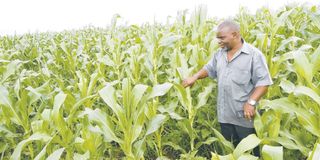4 money-spinning crops farmers should invest in

A farmer tends his maize crop. An international research firm says in a new report that coffee, maize, sugarcane and rice farming will be highly lucrative for Tanzanian producers in the next few years. PHOTO | FILE
Dar es Salaam. Coffee, maize, sugarcane and rice farming will be highly lucrative in the next few years, according to a new report.
The Tanzania Agribusiness Report for January 2018, published by Business Monitor International (BMI), says future demand for the four crops will be relatively high in both the domestic and export markets. BMI is a research firm that provides macroeconomic, industry and financial market analysis covering 24 industries and 200 global markets.
According to the report, the income levels of farmers involved in the production of the four crops will rise significantly between 2018 and 2021.
“Our view of the agribusiness sector in Tanzania remains broadly positive, with all of our output and demand forecasts for the four crops we track set to see growth across our forecast period.”
According to BMI, Tanzanians’ income levels will rise steadily going forward to the 2020/21 financial year, and this will increase rice consumption compared with other basic staples such as maize and cassava.
Demand for rice reached 2.05 million tonnes last year. It is projected that this will increase by 2.9 per cent during the five-year forecast period to 2.27 million tonnes.
However, it is forecast that the coffee sub-sector will face some challenges in the medium term both on the production and marketing fronts, and this may affect the crop’s production growth.
“We continue to see the Tanzanian coffee industry struggling over the medium term but we highlight that renewed government support for the sector has provided hope that it can recover over the longer term,” the BMI report says.
While rising incomes will boost rice consumption, maize farmers are expected to benefit, albeit modestly, from solid demand in the domestic and export markets. Domestic maize demand in 2017 was 5.1 million tonnes, down from 5.5 million tonnes forecast earlier.
“However, beyond 2017, we see demand beginning to recover once more. Despite the downward revision in our forecasts across each year of our forecast period, we see consumption rising by a more modest compound annual growth rate of 1.0 per cent to reach a level of 5.8 million tonnes in 2021,” the report says.
Maize production was 4.82 million tonnes in 2017 and has returned to a growth trajectory in 2018, with an annual growth rate of 1.4 per cent being forecast through to 2021 to 6.25 million tonnes.
The sugar sub-sector is expected to see limited production growth in the next few years, largely due to the fact that Tanzania scores poorly on productivity measures compared with its regional neighbours.
“We continue to believe that Tanzania will see its sugar production levels grow at only a very marginal rate (at an average of 0.6 per cent per year) across our five-year forecast period from 2017 through to 2021.”
The report adds that Tanzania will continue to see rising levels of sugar imports to meet its projected steady growth in demand over the next decade, climbing higher across BMI’s forecast period by an average annual growth rate of 2.0 per cent year.




